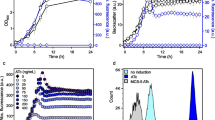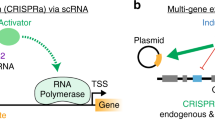Abstract
Vector-dependent gene overexpression typically relies on an efficient operon and sufficient RNA polymerases (RNAPs). The lac (lactose) operon is a paradigm of transcription control, and cyclic AMP receptor protein (CRP) is a global regulator capable of recruiting RNAPs. However, the gap between lac operon and CRP has not been well bridged. In this work, CRP was fused to lac repressor protein (lacI) to form an artificial transcription factor (ATF) with the expectation that when LacI acted on the lacO-positioned upstream of gene of interest, the LacI-tethered CRP would trap RNAPs and thus improve the expression of PuuC, an aldehyde dehydrogenase catalyzing 3-hydroxypropionaldehyde (3-HPA) to 3-hydroxypropionic acid (3-HP) in Klebsiella pneumoniae. As expected, SDS-PAGE and HPLC showed enhanced PuuC expression and 3-HP production, respectively, compared to the control strain without expressing chimeric protein LacI-CRP. Moreover, quantitative real-time PCR demonstrated increased transcription levels of both PuuC and RNAP coding genes. In shake-flask cultivation, the recombinant K. pneumoniae strain coexpressing LacI-CRP and PuuC produced 1.67-fold of 3-HP relative to the stain only overexpressing PuuC. In bioreactor cultivation, the strain coexpressing LacI-CRP and PuuC produced 35.1 g/L 3-HP, whereas the strain without expressing LacI-CRP generated only 9.8 g/L 3-HP. Overall, these results indicated that as an ATF, LacI-CRP significantly boosted PuuC expression and 3-HP production. We envision that LacI-CRP as a plug-and-play part can be used for regulating gene expression.





Similar content being viewed by others
References
Alper H, Stephanopoulos G (2007) Global transcription machinery engineering: a new approach for improving cellular phenotype. Metab Eng 9(3):258–267. https://doi.org/10.1016/j.ymben.2006.12.002
Alper H, Fischer C, Nevoigt E, Stephanopoulos G (2005a) Tuning genetic control through promoter engineering. Proc Natl Acad Sci U S A 102(36):12678–12683. https://doi.org/10.1073/pnas.0504604102
Alper H, Miyaoku K, Stephanopoulos G (2005b) Construction of lycopene-overproducing E. coli strains by combining systematic and combinatorial gene knockout targets. Nat Biotechnol 23(5):612–616. https://doi.org/10.1038/nbt1083
Becker NA, Peters JP, Lionberger TA, Maher LJ III (2013) Mechanism of promoter repression by Lac repressor–DNA loops. Nucleic Acids Res 41(1):156–166. https://doi.org/10.1093/nar/gks1011
Belyaeva TA, Rhodius VA, Webster CL, Busby SJ (1998) Transcription activation at promoters carrying tandem DNA sites for the Escherichia coli cyclic AMP receptor protein: organisation of the RNA polymerase alpha subunits. J Mol Biol 277(4):789–804. https://doi.org/10.1006/jmbi.1998.1666
Bonacci W, Teng PK, Afonso B, Niederholtmeyer H, Grob P, Silver PA, Savage DF (2012) Modularity of a carbon-fixing protein organelle. Proc Natl Acad Sci U S A 109(2):478–483. https://doi.org/10.1073/pnas.1108557109
Celinska E (2010) Debottlenecking the 1,3-propanediol pathway by metabolic engineering. Biotechnol Adv 28(4):519–530. https://doi.org/10.1016/j.biotechadv.2010.03.003
Chu HS, Kim YS, Lee CM, Lee JH, Jung WS, Ahn JH, Song SH, Choi IS, Cho KM (2015) Metabolic engineering of 3-hydroxypropionic acid biosynthesis in Escherichia coli. Biotechnol Bioeng 112(2):356–364. https://doi.org/10.1002/bit.25444
Conrado RJ, Wu GC, Boock JT, Xu H, Chen SY, Lebar T, Turnsek J, Tomsic N, Avbelj M, Gaber R, Koprivnjak T, Mori J, Glavnik V, Vovk I, Bencina M, Hodnik V, Anderluh G, Dueber JE, Jerala R, DeLisa MP (2012) DNA-guided assembly of biosynthetic pathways promotes improved catalytic efficiency. Nucleic Acids Res 40(4):1879–1889. https://doi.org/10.1093/nar/gkr888
Droge P, Muller-Hill B (2001) High local protein concentrations at promoters: strategies in prokaryotic and eukaryotic cells. BioEssays 23(2):179–183. https://doi.org/10.1002/1521-1878(200102)23:2<179::AID-BIES1025>3.0.CO;2-6
Dueber JE, Wu GC, Malmirchegini GR, Moon TS, Petzold CJ, Ullal AV, Prather KLJ, Keasling JD (2009) Synthetic protein scaffolds provide modular control over metabolic flux. Nat Biotechnol 27(8):753–759. https://doi.org/10.1038/nbt.1557
Forage RG, Lin EC (1982) DHA system mediating aerobic and anaerobic dissimilation of glycerol in Klebsiella pneumoniae NCIB 418. J Bacteriol 151(2):591–599
Gilbert W, Muller-Hill B (1966) Isolation of the lac repressor. Proc Natl Acad Sci U S A 56(6):1891–1898. https://doi.org/10.1073/pnas.56.6.1891
Huang L, Pu Y, Yang X, Zhu X, Cai J, Xu Z (2015) Engineering of global regulator cAMP receptor protein (CRP) in Escherichia coli for improved lycopene production. J Biotechnol 199:55–61. https://doi.org/10.1016/j.jbiotec.2015.02.006
Huston JS, Levinson D, Mudgett-Hunter M, Tai MS, Novotny J, Margolies MN, Ridge RJ, Bruccoleri RE, Haber E, Crea R (1988) Protein engineering of antibody binding sites: recovery of specific activity in an anti-digoxin single-chain fv analogue produced in Escherichia coli. Proc Natl Acad Sci U S A 85(16):5879–5883. https://doi.org/10.1073/pnas.85.16.5879
Jacob F, Monod J (1961) Genetic regulatory mechanisms in the synthesis of proteins. J Mol Biol 3(3):318–356. https://doi.org/10.1016/S0022-2836(61)80072-7
Johnson EA, Lin EC (1987) Klebsiella pneumoniae 1,3-propanediol: NAD+ oxidoreductase. J Bacteriol 169(5):2050–2054. https://doi.org/10.1128/jb.169.5.2050-2054.1987
Keasling JD (2010) Manufacturing molecules through metabolic engineering. Science 330(6009):1355–1358. https://doi.org/10.1126/science.1193990
Kiel C, Yus E, Serrano L (2010) Engineering signal transduction pathways. Cell 140(1):33–47. https://doi.org/10.1016/j.cell.2009.12.028
Ko Y, Ashok S, Zhou S, Kumar V, Park S (2012) Aldehyde dehydrogenase activity is important to the production of 3-hydroxypropionic acid from glycerol by recombinant Klebsiella pneumoniae. Process Biochem 47(7):1135–1143. https://doi.org/10.1016/j.procbio.2012.04.007
Kumar V, Ashok S, Park S (2013) Recent advances in biological production of 3-hydroxypropionic acid. Biotechnol Adv 31(6):945–961. https://doi.org/10.1016/j.biotechadv.2013.02.008
Lee JY, Sung BH, Yu BJ, Lee JH, Lee SH, Kim MS, Koob MD, Kim SC (2008) Phenotypic engineering by reprogramming gene transcription using novel artificial transcription factors in Escherichia coli. Nucleic Acids Res 36(16):e102. https://doi.org/10.1093/nar/gkn449
Li Y, Su M, Ge X, Tian P (2013) Enhanced aldehyde dehydrogenase activity by regenerating NAD+ in Klebsiella pneumoniae and implications for the glycerol dissimilation pathways. Biotechnol Lett 35(10):1609–1615. https://doi.org/10.1007/s10529-013-1243-1
Li Y, Li S, Ge X, Tian P (2016a) Development of red recombinase system and antisense RNA technology in Klebsiella pneumoniae for production of chemicals. RSC Adv 6(83):79920–79927. https://doi.org/10.1039/c6ra12511e
Li Y, Wang X, Ge X, Tian P (2016b) High production of 3-hydroxypropionic acid in Klebsiella pneumoniae by systematic optimization of glycerol metabolism. Sci Rep 6(1):26932. https://doi.org/10.1038/srep26932
Li YX, Yi P, Yan QJ, Qin Z, Liu XQ, Jiang ZQ (2017) Directed evolution of a β-mannanase from Rhizomucor miehei to improve catalytic activity in acidic and thermophilic conditions. Biotechnol Biofuels 10(1):143–154. https://doi.org/10.1186/s13068-017-0833-x
Martinez-Antonio A, Collado-Vides J (2003) Identifying global regulators in transcriptional regulatory networks in bacteria. Curr Opin Microbiol 6(5):482–489. https://doi.org/10.1016/j.mib.2003.09.002
Murakami KS, Masuda S, Darst SA (2002) Structural basis of transcription initiation: RNA polymerase holoenzyme at 4 Å resolution. Science 296(5571):1280–1284. https://doi.org/10.1126/science.1069594
Oehler S, Muller-Hill B (2010) High local concentration: a fundamental strategy of life. J Mol Biol 395(2):242–253. https://doi.org/10.1016/j.jmb.2009.10.056
Oehler S, Eismann ER, Kramer H, Muller-Hill B (1990) The three operators of the lac operon cooperate in repression. EMBO J 9(4):973–979
Peisajovich SG, Garbarino JE, Wei P, Lim WA (2010) Rapid diversification of cell signaling phenotypes by modular domain recombination. Science 328(5976):368–372. https://doi.org/10.1126/science.1182376
Pfahl M, Gulde V, Bourgeois S (1979) “Second” and “third operator” of the lac operon: an investigation of their role in the regulatory mechanism. J Mol Biol 127(3):339–344. https://doi.org/10.1016/0022-2836(79)90333-4
Prather KLJ, Martin CH (2008) De novo biosynthetic pathways: rational design of microbial chemical factories. Curr Opin Biotechnol 19(5):468–474. https://doi.org/10.1016/j.copbio.2008.07.009
Rhodius VA, Busby SJW (2000) Transcription activation by the Escherichia coli cyclic AMP receptor protein: determinants within activating region 3. J Mol Biol 299(2):295–310. https://doi.org/10.1006/jmbi.2000.3736
Sachdeva G, Garg A, Godding D, Way JC, Silver PA (2014) In vivo co-localization of enzymes on RNA scaffolds increases metabolic production in a geometrically dependent manner. Nucleic Acids Res 42(14):9493–9503. https://doi.org/10.1093/nar/gku617
Saravanan T, Junker S, Kickstein M, Hein S, Link MK, Ranglack J, Witt S, Lorillière M, Hecquet L, Fessner WD (2017) Donor promiscuity of a thermostable transketolase by directed evolution: efficient complementation of 1-deoxy-d-xylulose-5-phosphate synthase activity. Angew Chem Int Ed Engl 56(19):5358–5362. https://doi.org/10.1002/anie.201701169
Savery NJ, Lloyd GS, Kainz M, Gaal T, Ross W, Ebright RH, Gourse RL, Busby SJ (1998) Transcription activation at class II CRP-dependent promoters: identification of determinants in the C-terminal domain of the RNA polymerase alpha subunit. EMBO J 17(12):3439–3447. https://doi.org/10.1093/emboj/17.12.3439
Schmitz A, Galas DJ (1979) The interaction of RNA polymerase and lac repressor with the lac control region. Nucleic Acids Res 6(1):111–137. https://doi.org/10.1093/nar/6.1.111
Segall-Shapiro TH, Meyer AJ, Ellington AD, Sontag ED, Voigt CA (2014) A ‘resource allocator’ for transcription based on a highly fragmented T7 RNA polymerase. Mol Syst Biol 10(7):742. https://doi.org/10.15252/msb.20145299
Shis DL, Bennett MR (2013) Library of synthetic transcriptional AND gates built with split T7 RNA polymerase mutants. Proc Natl Acad Sci U S A 110(13):5028–5033. https://doi.org/10.1073/pnas.1220157110
Singh R, Kuscu C, Quinlan A, Qi Y, Adli M (2015) Cas9-chromatin binding information enables more accurate CRISPR off-target prediction. Nucleic Acids Res 43(18):e118. https://doi.org/10.1093/nar/gkv575
Stemmer WP (1994) DNA shuffling by random fragmentation and reassembly: in vitro recombination for molecular evolution. Proc Natl Acad Sci U S A 91(22):10747–10751. https://doi.org/10.1073/pnas.91.22.10747
Stephanopoulos G (2007) Challenges in engineering microbes for biofuels production. Science 315(5813):801–804. https://doi.org/10.1126/science.1139612
Sun J, Han Z, Ge X, Tian P (2014) Distinct promoters affect pyrroloquinoline quinone production in recombinant Escherichia coli and Klebsiella pneumoniae. Curr Microbiol 69(4):451–456. https://doi.org/10.1007/s00284-014-0607-7
Wang HH, Isaacs FJ, Carr PA, Sun ZZ, Xu G, Forest CR, Church GM (2009) Programming cells by multiplex genome engineering and accelerated evolution. Nature 460(7257):894–898. https://doi.org/10.1038/nature08187
Funding
This study was funded by grants from National Natural Science Foundation of China (Nos. 21276014, 21476011), National High Technology Research and Development Program (863 Program) (No. 2015AA021003), National Basic Research Program of China (973 Program) (No. 2012CB725200), and Fundamental Research Funds for the Central Universities (YS1407).
Author information
Authors and Affiliations
Corresponding author
Ethics declarations
This article does not contain any studies with human participants or animals performed by any of the authors.
Conflict of interest
The authors declare that they have no conflict of interest.
Electronic supplementary material
ESM 1
(PDF 100 kb)
Rights and permissions
About this article
Cite this article
Zhao, P., Wang, W. & Tian, P. Development of cyclic AMP receptor protein-based artificial transcription factor for intensifying gene expression. Appl Microbiol Biotechnol 102, 1673–1685 (2018). https://doi.org/10.1007/s00253-018-8750-x
Received:
Revised:
Accepted:
Published:
Issue Date:
DOI: https://doi.org/10.1007/s00253-018-8750-x




